November 13, 2023
What Is Virtual Staging With AI?
Virtual staging is the process of adding realistic furniture and decor to a photo of an empty or unfurnished room using digital tools. It is a popular real estate marketing technique used by real estate agents and photographers to showcase the potential of a property and attract more buyers.
The term “staging” was coined by Barb Schwarz in 1972, but virtual staging didn’t appear until the late 1990s and early 2000s with the development of more capable computer hardware and virtual staging software tools.
One of the latest innovations in virtual staging and the real estate industry is using artificial intelligence (AI) to create stunning and realistic images of furnished rooms in seconds instead of hiring a graphic designer to do the work.
In this article, we’ll discuss what virtual staging with AI is, how it works, its pros and cons, costs, and other aspects of this emerging technology.
Virtual Staging With Artificial Intelligence
Virtual staging with AI is the process of using AI-powered software to add virtual furniture and decor to an empty, unfurnished, or outdated room.
Unlike virtual staging with designers, which requires human intervention and can take hours or even days to complete, virtual staging with AI is fully automated and can produce results in seconds.
With this technology, realtors can easily, quickly, and cost-effectively stage a room in different styles and colors to fit their potential customers’ needs. It gives you a clear idea of each room’s potential once fully furnished.
Virtual Staging AI is the leading provider of AI virtual staging services. Its proprietary technology was developed in Harvard’s Innovation Labs and uses advanced machine learning algorithms to generate high-quality images of virtually staged rooms.
How Does it Work?
Virtual staging with AI is a simple and straightforward four-step process.
Step #1 Take a Photo of the Room
The first step is to take a picture of the space you plan to stage. You don’t need to hire a professional photographer or use any special equipment. In fact, any modern smartphone camera will do.
Pro tip: When virtually staging with AI, it’s essential that the room is clean and free of any clutter or personal belongings before you take the picture. This setup will make it easier for the AI to recognize space and accurately place the objects within it.
The following two images show the dos and don’ts of photos for virtual staging with AI.
Ideal photo: The room is completely empty, clean, and well-lit.
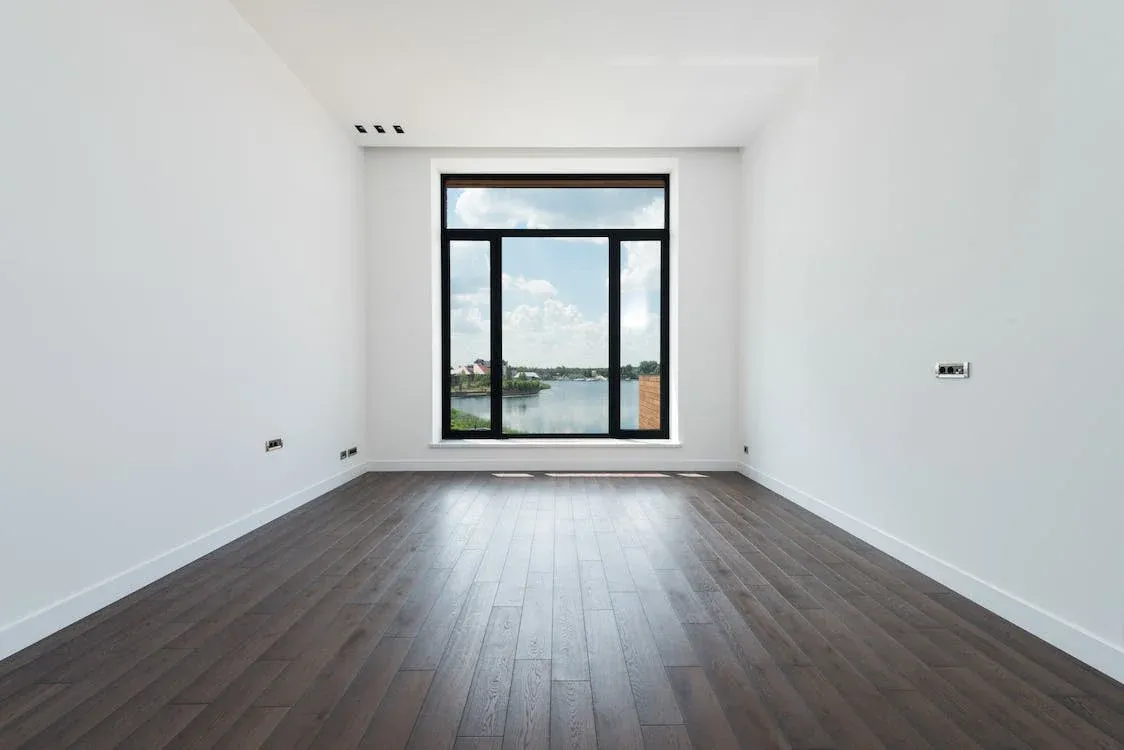
Not an ideal photo: The room is obviously dirty, deteriorated, and has poor lighting.
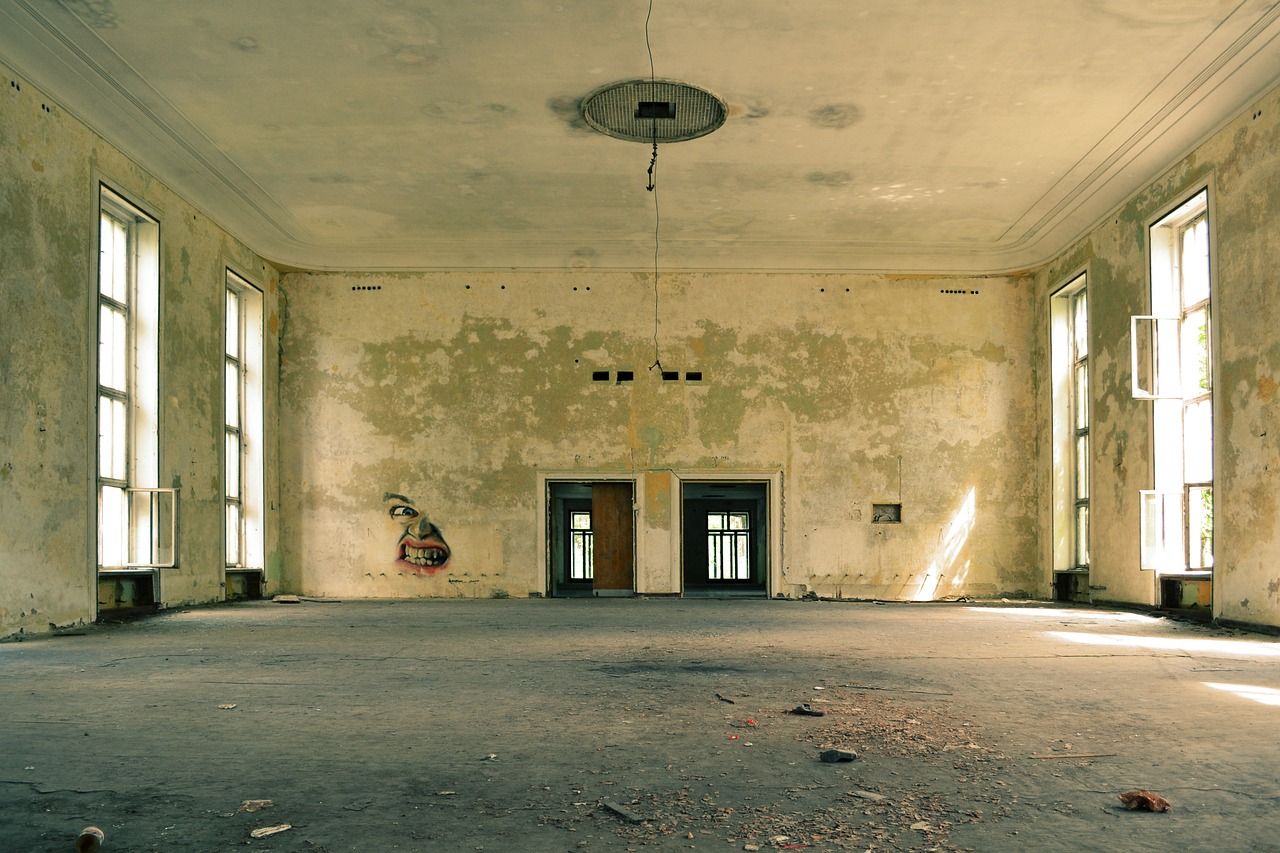
Step #2 Upload the Photo to the Virtual Staging AI Website
Uploading the digital image to the Virtual Staging AI platform is as simple as dragging and dropping the image file into the upload box on the home page.
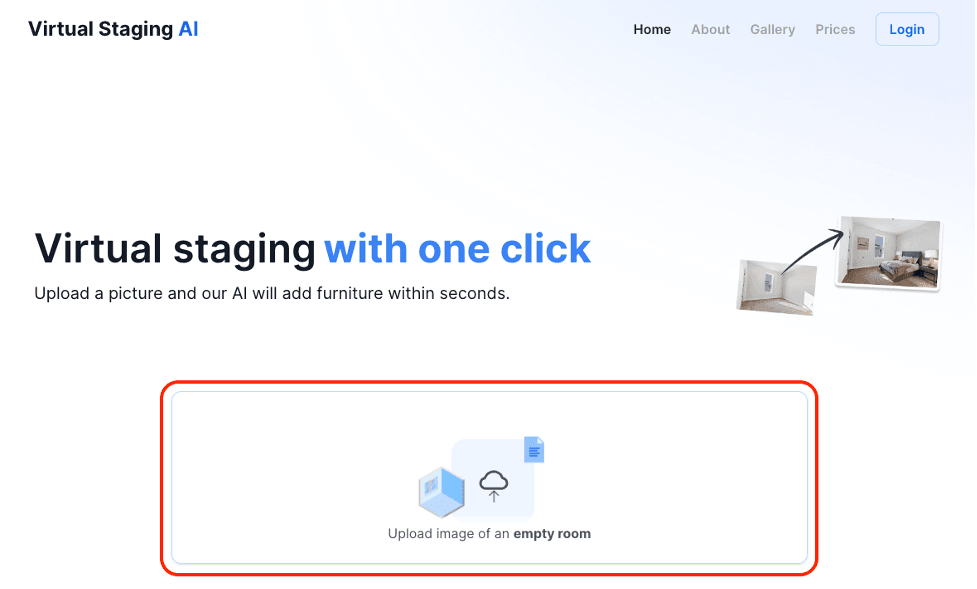
Step #3 Choose the Type of Room and Style of Furniture
Once uploaded, you must select the type of room you’re staging from a dropdown list with six different options, including:
-
Bedroom
-
Living room
-
Kitchen
-
Bathroom
-
Home office
-
Dining room
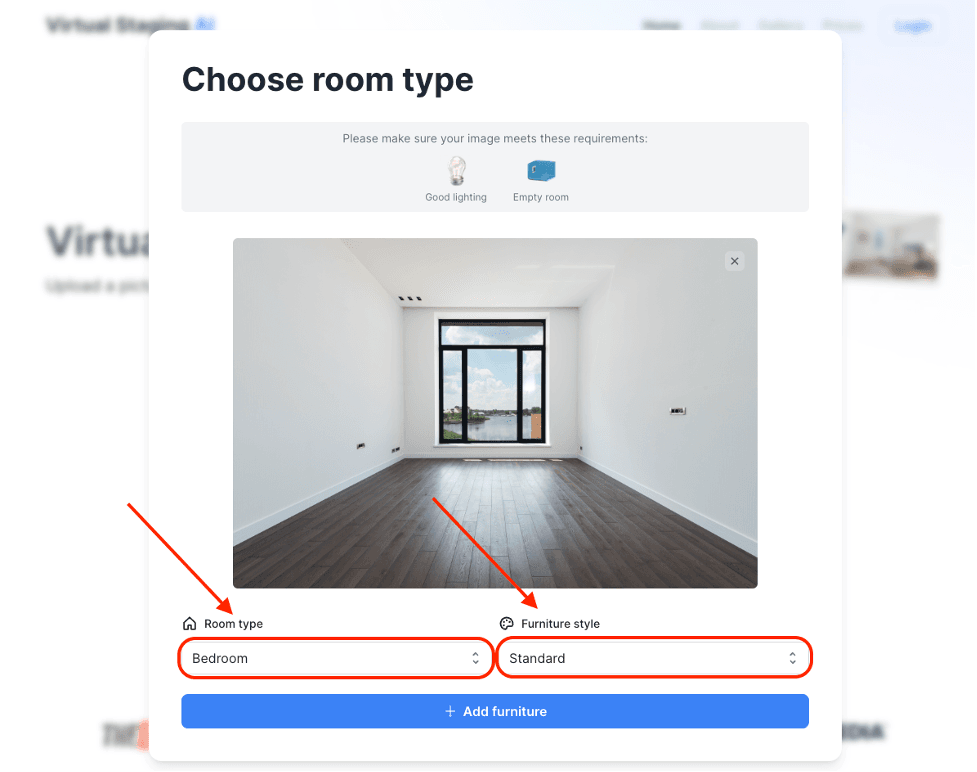
You must also tell the AI what type or style of furniture you want it to fill the room with. The currently available options are:
-
Standard
-
Modern
-
Scandinavian
-
Industrial
-
Midcentury
-
Luxury
-
Coastal
-
Farmhouse
Step #4 Add Furniture
Once you’re satisfied with the type of room and furniture style, you must click on the “+Add furniture” button at the bottom, and you’re set.
The AI will analyze the photo, generate the furniture matching the color of the room and the style you chose, and add it to the photo in a matter of seconds.
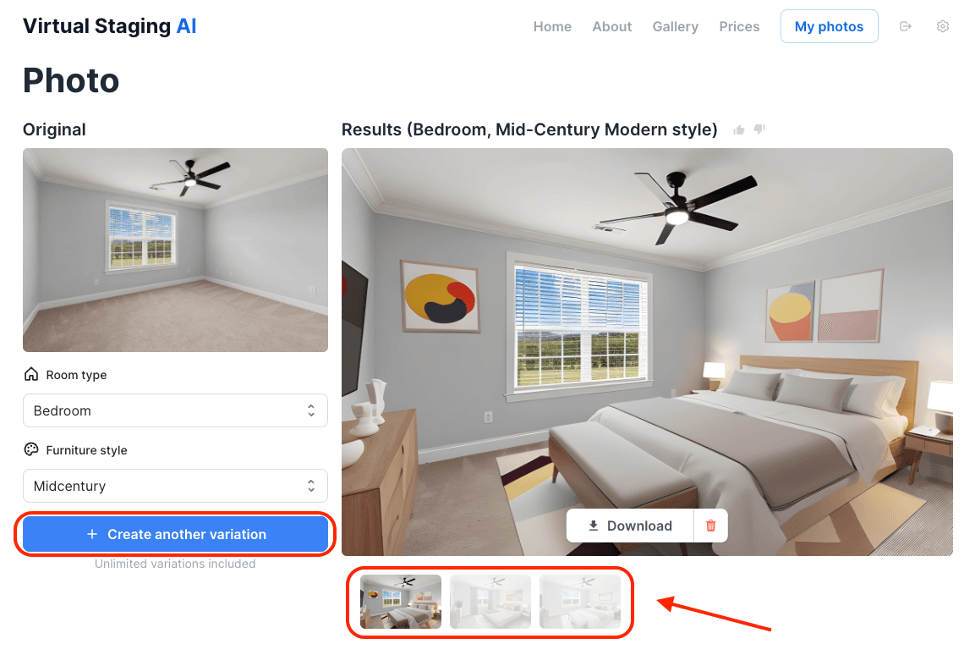
Render done with Virtual Staging AI
The AI will initially generate three variations of the staged room. If you don’t like any of the options, you can just hit the “Create another variation” button, and it’ll generate another set of three digital renderings (don’t worry, you won’t lose the first three).
Benefits of Virtual Staging With AI
Compared to virtual staging using a professional designer, virtual staging with AI has the following benefits:
-
Cost-effectiveness: Virtual staging with AI is much cheaper than digital staging with designers or traditional staging. For example, Virtual Staging AI offers flexible pricing plans starting at just $12/mo for six photos.
-
Ease and convenience: As you saw in the section above, Virtual Staging AI is very easy to use. Using your smartphone or computer, you can stage any room in minutes, making it a more convenient alternative.
-
Fast turnaround time: The whole process, from taking a photo of a room, uploading it to the virtual staging platform, and generating three different renders, takes less than a minute.
-
Variety and customization: Virtual staging with AI gives you access to a large and diverse collection of AI-generated furniture and decor items. You can mix and match to create different looks and styles. It’s perfect for showcasing the same room in multiple ways to appeal to different buyers, and they can then recreate their favorite design if and when they buy the property.
Virtual Staging With AI vs. Virtual Staging With Designers
Virtual staging with AI and virtual staging with designers are two different methods of creating images of furnished rooms using digital tools. Both methods have pros and cons, depending on your needs, budget, and preferences.
Here’s a brief comparison of the two:
Pros of Virtual Staging With Designers
-
Human touch: Virtual staging with designers involves human input and creativity, which can result in more unique and personalized images. Designers can also consider buyer-specific requests and create custom rooms.
-
More design options: A human designer can go beyond the types of rooms AI apps can generate. They can also work with more furniture styles and colors, add exterior renders, and more.
-
Enhance photos before staging: Designers can use their expertise in interior design, photography, and virtual staging software to retouch photos, remove eyesores like visible cables and defects on the walls, and more before adding the furniture.
Cons of Virtual Staging With Designers
- High cost: Virtual staging costs are higher with designers than with AI. Prices start at $24 per image. Depending on the staging company, you may have to pay extra for revisions, rush orders, or custom furniture.
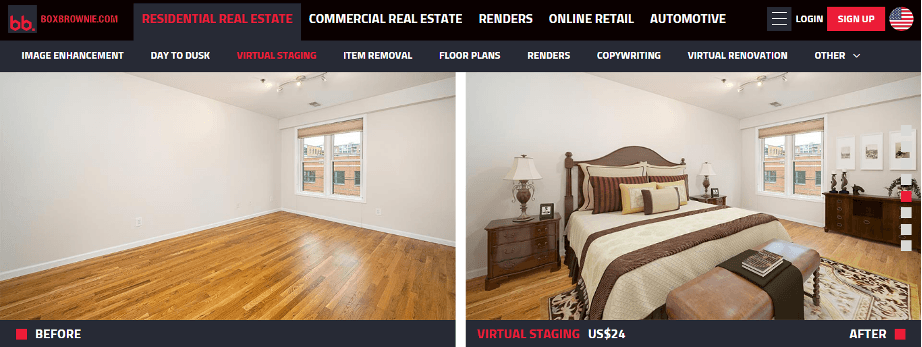
-
Long turnaround time: The average turnaround time for virtual staging with designers is 24 to 48 hours (sometimes up to two weeks or more), while AI virtual staging only takes a few seconds.
-
Stringent image requirements: Some virtual staging companies and individual designers require professionally taken, high-res photography, which isn’t necessary for virtual staging with AI.
Pros of Virtual Staging With AI
-
Low cost: Virtual home staging with AI is much cheaper than virtual staging with designers or traditional staging. Staging photos with Virtual Staging AI costs a maximum of $3 per photo and a minimum of $0.28 in both cases, with unlimited revisions and renders.
-
Fast turnaround time: Virtual Staging AI can deliver three renders of the same staged image in as little as 10 seconds, making it orders of magnitude faster than virtual staging with designers or traditional staging.
-
Ease and convenience: With Virtual Staging AI, you don’t need to hire a professional photographer to take the pictures. You can take them yourself with your smartphone and stage the room right away, making it more convenient.
Cons of Virtual Staging With AI
-
Lack of human touch: AI algorithms may not be able to capture the nuances and subtleties of interior design, photography, and software that human designers can.
-
Potential errors and glitches: As with all generative AI models, virtual staging with AI isn’t perfect. It may produce errors and glitches, such as overlapping furniture, mismatched colors, or distorted perspectives. For example, look at how the AI misread the dimensions of the room when we fed it a bad input photo.
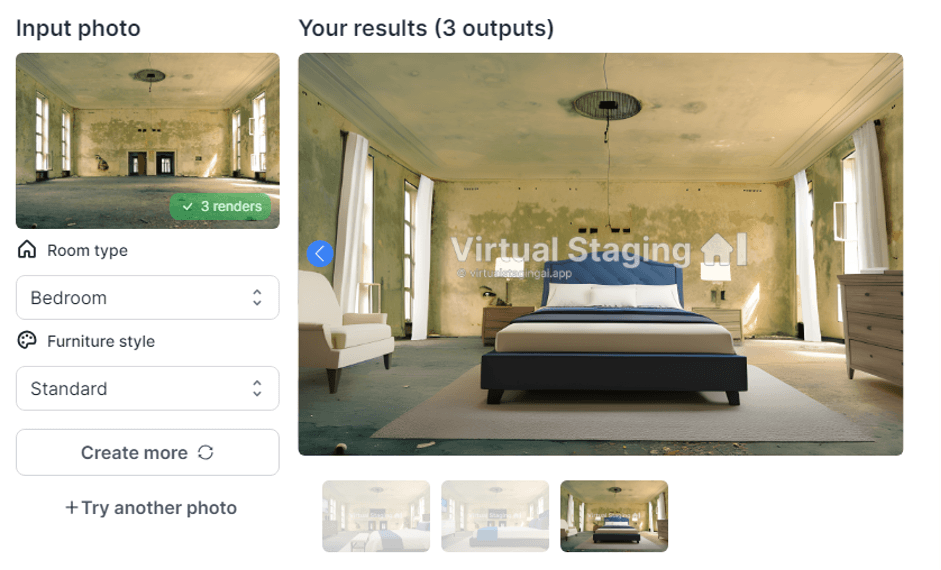
- Limited design options: Virtual Staging AI currently offers staging for only six types of rooms using eight furniture styles, leading to only 48 unique room-style combinations. We currently can’t stage special rooms like home gyms or children’s playrooms, for example. That said, more options are coming soon.
Cost Comparison Between Traditional and Virtual Staging
Contrary to virtual staging (with or without AI), traditional staging involves physically furnishing and decorating a property using real furniture and decor items. Both methods have their advantages and disadvantages, but where they differ the most is in costs.
Here’s a brief comparison of the cost of traditional and virtual staging:
Average Cost of Traditional Home Staging Services
Traditional or physical staging services can be quite expensive. The average cost of traditional home staging services in the US is around $1,770, but it can range from $500 to $5,000 or more.
Some of the factors that can affect the cost of traditional home staging services are:
-
Rental fees: These are the fees you pay to rent the furniture and decor items from the staging company or a third-party vendor. The rental fee can vary depending on the type, style, and number of furniture and decor items you need, as well as the duration of the rental period. Furniture rental fees for traditional home staging services can range from $300 to $3,000 (after initial setup) and average about $2,000 per month.
-
Staging fee: This is the fee you pay to the staging company for their services, such as consultation, design, delivery, installation, and removal of the furniture and decor items.
-
Other expenses: Besides rental and staging fees, you may also incur other expenses during staging, such as cleaning, painting, repairing, or renovating the property, as well as storing, moving, or insuring the furniture and decor items.
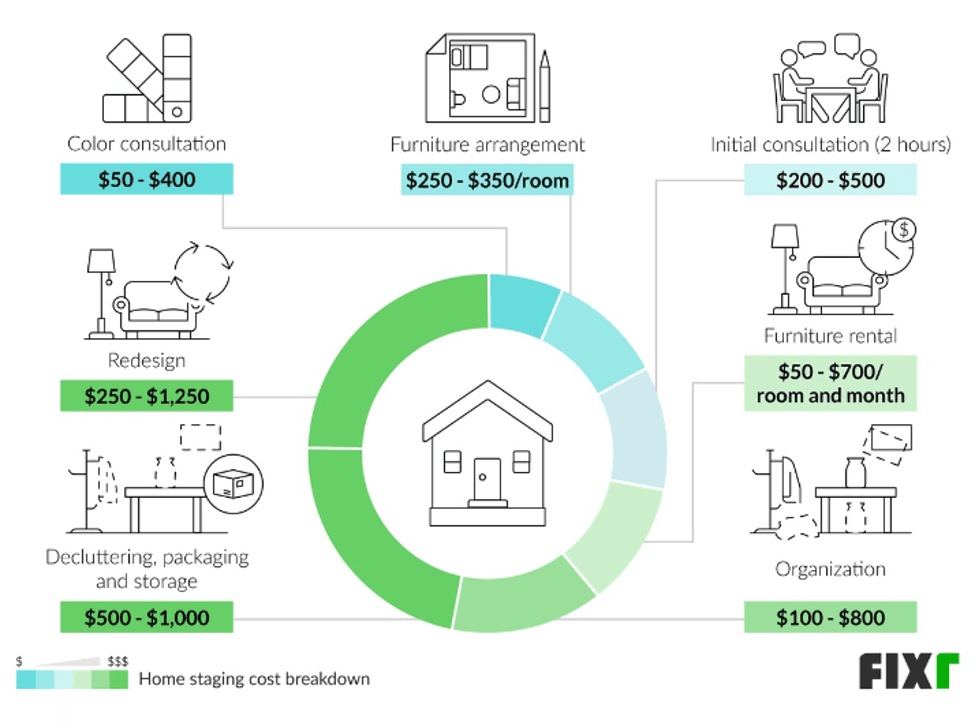
For example, staging a four-bedroom vacant home in Los Angeles can cost $2,300–$3,000 per month or $7,000–$9,000 for a typical three-month staging period.
Average Cost of Professional AI Virtual Staging Services
Professional AI virtual home staging services are much cheaper than traditional home staging services, as they don’t involve any physical furniture and decor items. However, costs can vary depending on:
-
The number of photos you plan to stage per month.
-
Personalized support.
-
Access to an API.
Virtual Staging AI offers four subscription plans starting at $12 per month. The following table compares these four plans in terms of pricing and the features they offer.
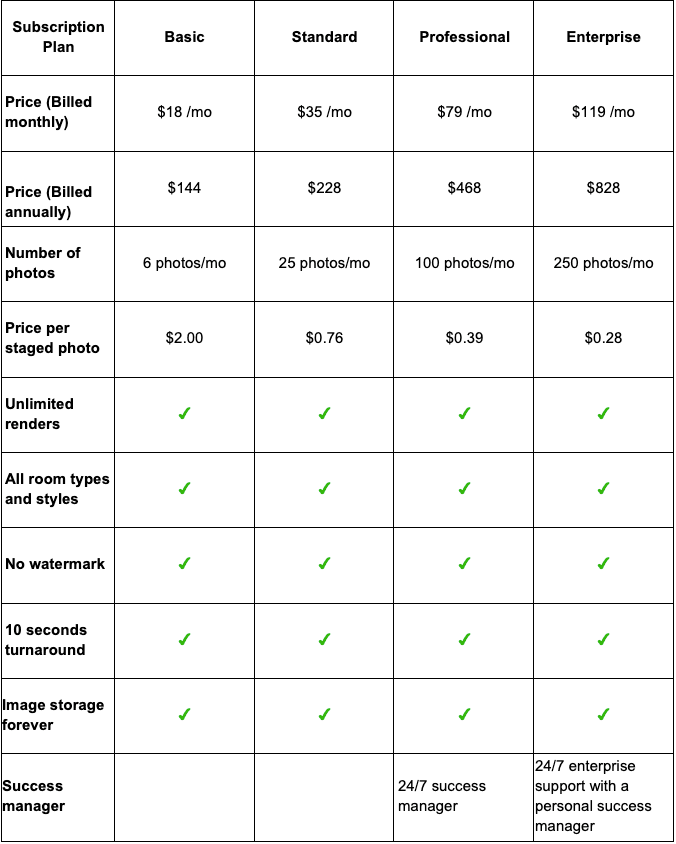
For example, suppose you wanted to stage the same four-bedroom home in LA we mentioned above.
You could sign up for Virtual Staging AI’s Basic plan for just $12, take six photos of the rooms you want to stage, and create as many renders as you want. That sure beats shelling out nearly $10,000 on traditional staging costs.
Who Can Benefit From Virtual Staging?
Virtual staging isn’t only beneficial for real estate agents but also for real estate photographers and potential buyers.
Here’s how each group can benefit from virtual staging:
Real Estate Professionals/Agents
Real estate professionals or agents can use virtual home staging to market their properties more effectively and efficiently. Some of the specific advantages of virtual staging over traditional staging for professional agents are:
-
Cost-effectiveness: Virtual staging can help real estate agents save a lot of money on staging costs. Instead of paying thousands of dollars for traditional staging services, they can pay a fraction of that amount for virtual staging services. This can improve their return on investment (ROI) and increase their profit margin.
-
Ability to showcase different styles on demand: Virtual staging can help real estate agents appeal to a wider range of buyers by showing them different furniture styles according to their tastes and preferences.
-
Faster and easier staging process: Instead of hiring a stager, renting, delivering, and setting up furniture, and removing furniture, realtors can simply upload a photo, choose a style, and get a staged photo in seconds. They can also make changes or revisions anytime they want without any hassle.
Having said that, virtual staging also has some potential drawbacks, such as the inability to physically experience the space and the possibility of misleading or disappointing buyers.
Real Estate Photographers
Real estate photographers can use virtual staging to enhance their real estate photos and offer additional services to their clients, like virtual renovations.
Virtual staging with AI offers the ability to process photos faster and at a fraction of the cost of sending the photos to a designer. This dramatically increases ROI and offers a competitive edge over other photographers who don’t offer this additional service.
Prospective Buyers
Potential buyers can use virtual staging to help them make a better and faster decision about buying a property. For example, virtual staging allows buyers to visualize themselves living in a furnished and decorated space
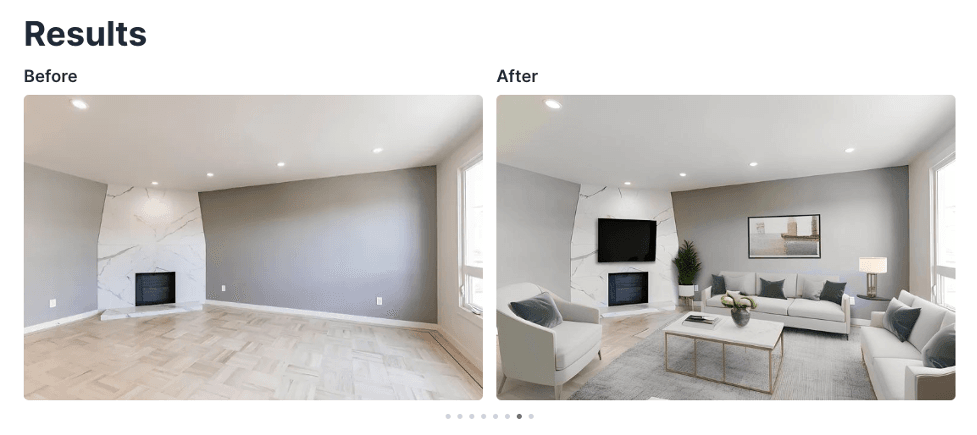
AI digital staging can also help them find their preferred style and match their personality and lifestyle by allowing them to test different styles in the same room.
Have You Tried Virtual Staging With AI Yet?
Virtual staging with AI is a revolutionary technology to help real estate professionals market their properties more effectively and efficiently. It can also help prospective buyers visualize and compare different properties and styles and make a better and faster decision.
Virtual Staging AI is the leading provider of virtual staging with AI services, offering a web-based platform that can generate high-quality and realistic staged photos in seconds. The platform is a more convenient, faster, and cost-saving alternative to traditional and virtual staging with a designer.
If you’re interested, you can try Virtual Staging AI for free to stage a photo of a bedroom or a living room (without signing up or providing credit card information). In seconds, you’ll get the actual result with a watermark.
Ready to ditch the watermark? Sign up for a paid plan for downloadable high-quality images your clients will love.